 abs
- rectus abdominis - storage area for fat. The abs draw
the upper body toward the lower body. The abs are commonly refered
to as lower abs and upper abs - different movements tend to place
greater stress on one area or the other. abs
- rectus abdominis - storage area for fat. The abs draw
the upper body toward the lower body. The abs are commonly refered
to as lower abs and upper abs - different movements tend to place
greater stress on one area or the other.
external
obliques
- another great area to store up those fat
cells.
Located on the sides of the waist their basic function is to bend
and twist the upper body.
|
| |
Crunches
This
is the safest and most effective abdominal exercise you can do. Make sure
you keep your elbows in a wide flared position and don't pull on your neck
too hard. Concentrate on using only your abdominal muscles to elevate your
torso, pause slightly at the top of the movement to really flex the abs.
* Muscle Confusion Tips,- Twivtyour torvo either leji or right asyou
lift upward to work the obliques or side abdominals. Vary the speed at
which you perform from a rapid cadence with more rep to a slow and
deliberate one with lower reps. |


|
Abdominal Machine
There should be a couple of different
machines at the gym, give them all a try. This is very similar to a crunch, with the exception of weight
resistance. This is a great movement
that can really thrash your abdominals.
* Muscle Confusion Tips: Twist your torso either left or right as you
lift upward to work the obliques or side abdominals. Vary the speed at
which you perform from a rapid cadence with more reps to a slow and
deliberate one with fewer reps.. |
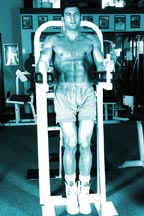
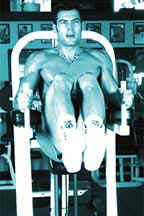
|
Leg
Raises
This
movement really concentrates on the lower abdominal muscles. Be careful if
you have a bad lower back, as this movement places a little stress on the
muscles in your lower back. As you bring your knees to your chest area you
should feel all the muscles in your abdominal area tighten and contract,
as you lower your knees you will feel the concentration move as the lower
abdominals control the downward movement.
*Muscle Confusion lips: Twist your torso either left or right as you
lift upward to work the obliques or side abdominals. You can also try
straightening out your legs more and more. This will really increase the
reviviance and should lower your reps considerably. Vary the speed at
which you perform from a rapid caden with more reps to a slow and
deliberate one with fewer reps. |
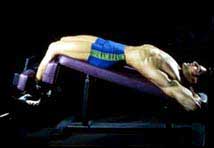
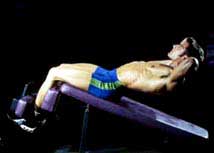

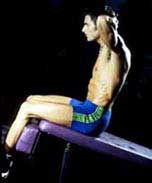
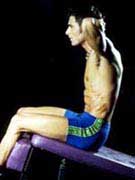
|
Remember the
3 things you were judged on in junior high school fitness tests? Push-ups, and
sit-ups. As you began bodybuilding, the first 2 were replaced by various
versions of lying press: push-ups were supplanted by bench presses, incline
dumbbell presses, decline press, etc. Pull-ups where discarded in favor of lat
pull downs, rowing and the occasional wide grip pull up behind the
neck.
But despite
twists, crunches, leg raises, knee lifts --- and even Richard Simmons --- the
sit-up remains as much part of bodybuilding as the Mr. universe title. For a few
good reasons: the sit-up is an excellent beginning ab exercise. It works a
middle and mid-upper abdominal muscle range that is prone to quick noticeable
changes (meaning your girl friend will see the improvements relatively quickly).
Other reasons
for the sit-ups longstanding vogue center on its variations, making the sit-up
suitable for intermediate and advanced ab work: By altering the bench and leg
angles, the area emphasis can be shifted and the movement made far more taxing.
Incline the bench and your work a lower ab section than you would on a flat
bench, making the incline sit up an intermediatary step before more advanced ab
work like knee-ups.
Twist on your
way up and down and obliques and stabilizers are pulled into play. Pull your
legs in as tight as possible to your buttocks and the movement becomes more
difficult. Because the sit-up has so many variations, including concentric and
eccentric tempo, and the possibility of additional weight resistance, it
applications are endless.
If fact,
there is just a few caveats to remember before you begin a sit-up
routine:
1) Never do
the sit-up with straight legs. This lessens abdominal work, may stress lower
vertebrae and increase hip flexor involvement.
2) Remember
to breathe. If you are doing your sit-ups slowly --- more a couple of seconds up
or down --- you should begin to exhale just before you being the "up" portion.
If you are doing sit-ups quickly, keep the exhalation going through multiple
reps, and inhale rapidly during on "down" segment.
3) Sit-ups
work best if you do not allow your upper body to completely come to rest on the
bench, which would correspond to a lockout, relieving the desirable constant
tension.
Sets &
Reps
For beginners, attempt one set of 10 to 15 fairly slow reps. After coming
up, let
the weight of your body pull you back gently to almost a lying position. Most
beginners keep their hands near their hips, then graduate to placing their hands
crossed on their chest, which increases the effective weight slightly (placing
hands behind the neck, as shown her, increases this more, but there is often a
tendency to pull forward with the hands, which can stress neck vertebrae
unnecessarily. Try a light weight held to your chest instead).
|
|
In the spirit
of (kind of) going from the bottom up, I will now talk about abs. Oh, those
precious abs. If you can't see 'em, chances are no exercise directed towards
them is gonna help too much. You need to burn off the fat in order to see your
abs. But the bigger they are, the sooner you'll (kind of) see them. So let's
talk abs!
|
 |
Crunches
By far the most basic exercises, and by no means to
be mistaken with sit-ups. Don't waste your time on sit-ups! They're not to
too good for your lower back, and work the muscle that pulls your spine
towards your hips, not your ribcage. You need to focus on pulling your
ribcage towards your hips. That is the essence of the crunch!
- You ever heard of a Swiss ball? It's a large rubber
ball, and crunches are
great when lying on it. Basically, you should want to extend your range of
motion, which a Swiss ball easily facilitates. Your abs are more stretched in
the starting position than when you are just lying on the floor, and your rep
covers about 30% more range of motion. An decline bench doesn't really work
any better than lying on the floor, cause your still just lying on a flat
surface, and your range of motion isn't increased. If you don't have Swiss
ball, you could try lying on a sofa or bed, with your shoulders just hanging
over the edge.
- Another contraption some gyms may have is like an incline bench with a
hump that sticks out and supports your lumbar (lower back) region. Then it has
a rope attached to a cable/pully system, and you hold the rope in both hands
over your shoulders. This provides the resistance as you pull your torso
forward and down.
- Do slow contractions, really squeezing it. Don't try to pump out 50! Using
the method just described to increase your range of motion really helps you to
make a slow contraction. And putting some weight on your chest will make it
burn like never before! Abs are a fast twich fiber, so you want to keep reps
low around 6-10.
|
 |
Hip raises
Not leg raises, but hip raises. What you do is lie
flat on the floor, steady yourself with your hands, and raise your legs so
they're pretty much straight up (you could also put your hands under your
glutes for support, and a self-spot). Then lift your hips off of the floor. These target the lower abs, which are often a tough spot to hit.
- Keep your lower back on the ground. This may not make
sense, but trust me,
you should only be lifting your hips off the ground, and if you're doing it
right, they won't lift more than two inches.
- Try and do it slow, though you may find this hard to do. I haven't yet
perfected this exercise myself, so try different things, different hand
positions, bend your knees, etc. Just don't use momentum by swinging
your legs!!
|
 |
Sweat Those Abdominals!
Each set consists of eight
repetitions. To warm up: Do a set at fifty percent of your maximum
effort. Begin with three sets of eight. When you can't break a sweat
with that, add five more reps to each set.
Crunch.
Lie on your back, with your knees bent, feet together and about 12
inches from your butt. With your arms crossed comfortably over your
chest, curl your torso until your shoulder blades rise about six
inches off the floor. Hold for a second. You should feel a slight
burn.
|
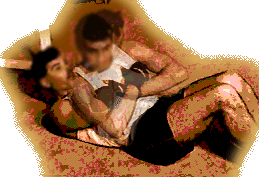 |
Twisting
crunch. Lie on your back, with your knees bent, feet
together and about 12 inches from your butt. With your arms crossed
comfortably over your chest, curl your left shoulder toward your
right knee until your left shoulder blade comes off the floor. Then
come back down. Next, curl your right shoulder toward your left knee.
Hold for a couple of seconds at the top of each movement.
|
 |
Seated
barbell twist. Sitting on the end of an exercise bench,
place an barbell across the back of your shoulders. Keep your lower
body facing forward and twist your torso to the left, back to the
center, to the right, and then back again.
|
 |
Side
bend. Stand with a dumbbell in your right hand. With your
back straight, slowly bend to the right as far as possible. Return
to the starting point, and bend to your left. Do this eight times,
then switch sides. The one to do if you're doing only one? Crunch.
Repompe de: http://www.manslife.com/fitness/bigsweat/sweatpages/abs/abs.html
|
|
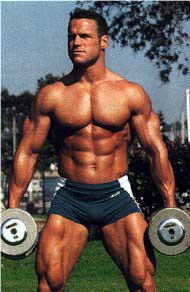
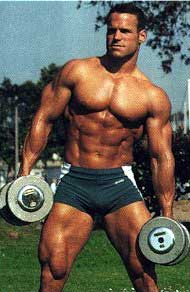
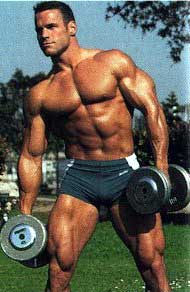
WEIGHTED SIDES BENDS
Stand upright with the feet
spread outside shoulder width, holding a dumbbell in each hand at the sides in
a palms-in grip. Keeping your hips stable, bend at the waist to one side until
you feel a stretch in your opposite side's muscles. Move back to the erect
starting position and continue down to the other side. Continue back and forth
from side to side in a smooth, but quick pace, breathing normally.
|
|
[ Tips for beginners ] [ guns ] [ tri ] [ chest ] [ back ] [ delts shoulders ] [ abs ] [ quads hams ] [ tips ] [ tips - next ] [ composition des aliments ]
| |
|